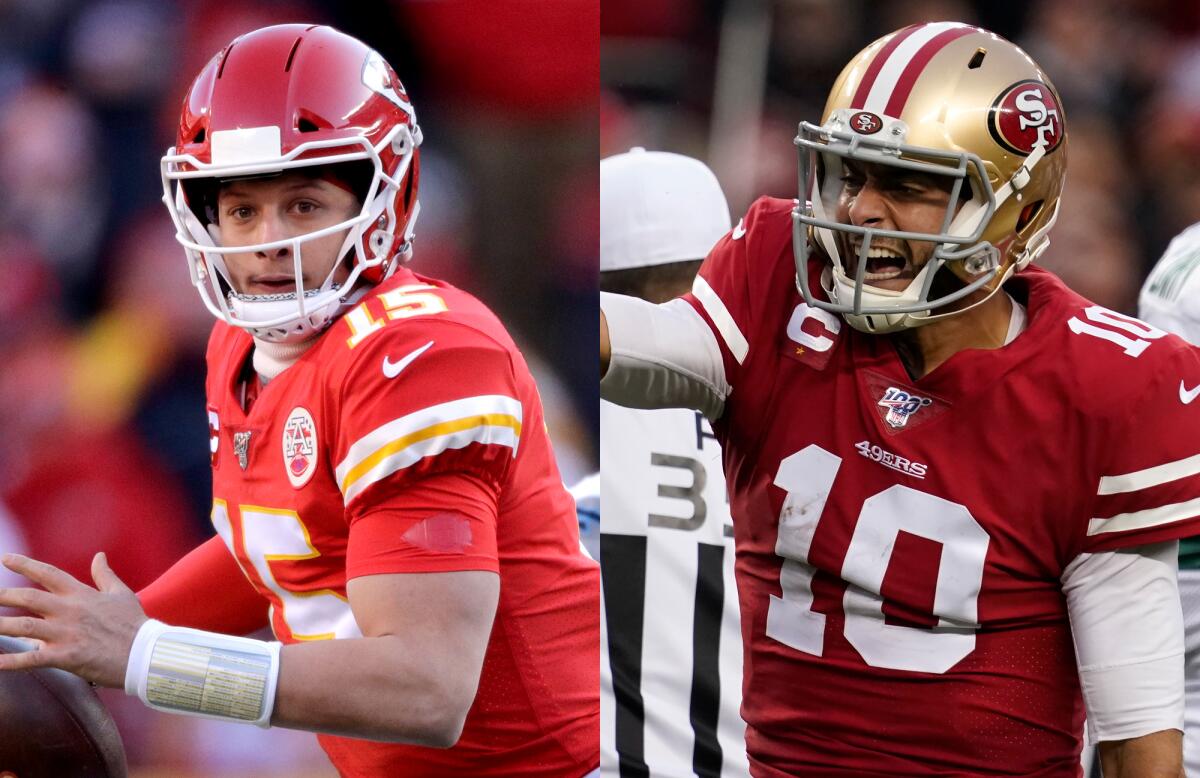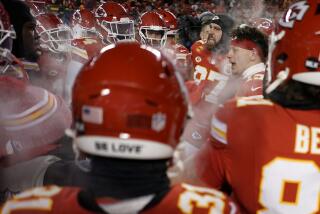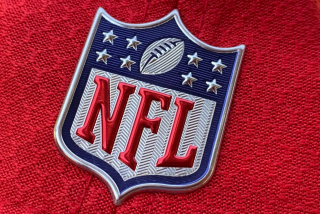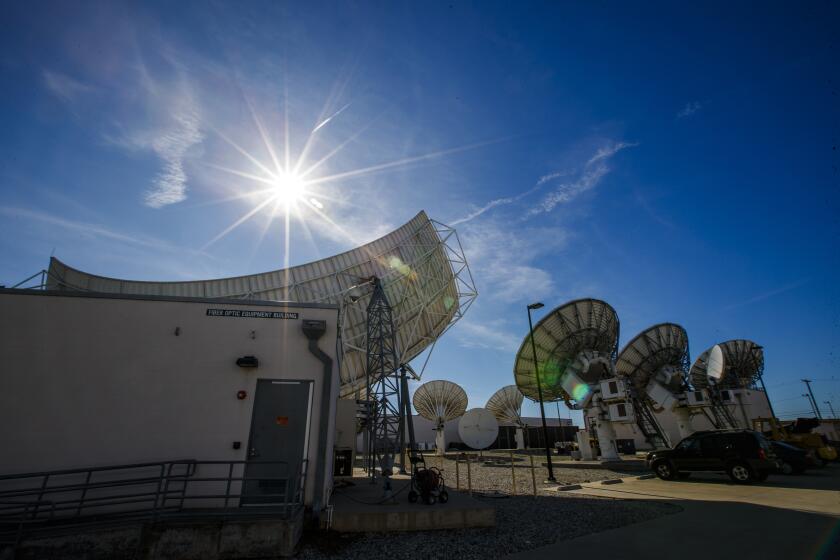Super Bowl 2020 looks bigger than ever as other TV audiences shrink

No matter what the score is for the Kansas City Chiefs’ showdown with the San Francisco 49ers, Super Bowl LIV is already a big win for the NFL and Fox.
Advertising for the game airing Sunday from Miami sold out before the end of November at prices topping out at $5.6 million for a 30-second commercial.
The figure is a 5.5% increase over last year, despite a 5% decline in audience for last year’s game that was watched by 98.2 million viewers on CBS. Live sports have held their own against the tide of video streaming that has pulled viewers away from traditional TV. As a result, the NFL’s relative strength to other programming is more valuable than ever to advertisers.
The demand for ads for Super Bowl LIV was so strong that Fox added 2.5 minutes of commercial time to the game.
The early sellout is unusual, said Adam Schwartz, senior vice president and sports media director at the New York ad buying firm Horizon Media. He noted there are typically more than a handful of commercials available in the days leading up to the kickoff.
“This is the first year in my memory that it was pretty much done by Thanksgiving,” Schwartz said.
The strong sales mean the game is likely to top the $335.5 million in ad revenue CBS pulled in last year, according to data from Standard Media Index. NBC collected $336.6 million in 2018.
The spending bonanza comes at a fortuitous time for the NFL as it prepares for negotiations on its next television contract, expected to be completed this year after the league hammers out a new labor pact with its players.
“It’s the end of the season but in a certain respect it’s the starting gun for a frenzied set of negotiations that will get into high gear after the collective bargaining agreement is done,” said Lee Berke, president and chief executive of the consulting firm LHB Sports, Media & Entertainment. “When it’s all said and done across all platforms and all content, I think the NFL will come close to doubling its rights payments.”
The current TV rights deal for CBS, NBC and Fox, is not up until 2022. But the NFL is expected to strike while the iron is hot, as viewership for regular season games increased for the second straight year after alarming audience downturns in 2016 and 2017, when the game battled controversies over concussions and some players kneeling during the national anthem to protest social injustice.
The increase in viewership has eased fears that TV’s most popular sports property would also be hurt by audience fragmentation.
The league now receives a total of $3.7 billion annually for the broadcast rights for the Sunday and Thursday games, playoffs and the Super Bowl. Walt Disney Co.’s ESPN pays $1.9 billion a year for “Monday Night Football,” a deal that is up in 2021.
Although the broadcast networks are expected to retain their packages -- with Disney’s ABC looking to get a portion as well — streaming platforms such as Comcast’s Peacock, Disney’s ESPN+, Amazon, Apple TV and DAZN are expected to go after NFL content for their offerings.
The league’s Sunday Ticket package, which offers out-of-market games to AT&T’s DirecTV customers, is also expected to be a target for streamers. AT&T currently pays $1.5 billion a year for Sunday Ticket. The NFL’s London games could also be carved out as a separate offering.
“You’ve never had a greater array of well-financed media outlets that are ready to pounce on the NFL to come up with packages that help them drive their respective multiplatform strategies,” Berke said.
While overall viewing of the NFL was up last year, the Super Bowl’s audience of 98.2 million viewers marked the first time since 2010 that the event was less than 100 million viewers. The figure does not include fans who watched a livestream of the game online, which this year is expected to be about 2 million to 3 million viewers this year.
Last year’s TV ratings drop has been attributed to the lack of scoring in the game, a defensive contest that saw the New England Patriots top the Los Angeles Rams 13-3. The one touchdown in the contest came in the fourth quarter.
“If you like punting, last year’s Super Bowl was your day,” said Mike Mulvihill, executive vice president for research, league operations and strategy for Fox Sports. “We have a lot of reason to believe that the game will be more exciting this year.”
Mulvihill believes ratings will get a lift from the matchup of the Chiefs and 49ers because the game presents a generational changing of the guard on the field. The Chiefs are led by quarterback Patrick Mahomes, the ideal representative of the explosive young stars who have emerged in the league over the last two seasons. He faces a revitalized 49ers team that established itself as a pass-rushing powerhouse this past season.
But even if Super Bowl LIV audience hovers around last year’s levels, the game will still tower over the rest of the television landscape at a greater height than ever before as non-sports audiences continue to shrink and viewers spend less time with traditional TV and watch more streaming video. The entertainment programs to come closest to the Super Bowl in 2019 were ABC’s telecast of the Oscars, with 29.6 million viewers and the series finale of the CBS sitcom “The Big Bang Theory,” with 24.8 million viewers.
The shrinking number of opportunities to reach a massive number of viewers in one shot is becoming more apparent to advertisers, which may account for the increased interest in running glossy, celebrity-studded commercials in this year’s Super Bowl even with the game’s staggering price tag.
“The diminishment of everything else on linear television is a factor,” said Horizon’s Schwartz. “If you’re a younger brand that is trying to establish yourself, this is the only place to do it.”
Fox does not reveal the lineup of advertisers before the game. But Schwartz believes that increased spending by technology companies are a factor in driving up the demand for the game as they have stepped up their TV ad spending overall in recent months.
Last year, technology companies spent $108.2 million on the Super Bowl, a 58% increase over 2018, according to Standard Media Index. The figure topped spending for the consumer package goods category, which includes the wide array of snack food and beverage brands seen advertised on the game.
This year Amazon, Google and Microsoft all have commercials in Super Bowl LIV. Facebook is running its first-ever Super Bowl ad featuring actors Sylvester Stallone and Chris Rock.
Even though the 2020 presidential campaign is still in the primary season, two candidates have 60-second ads running in the game, each costing $10 million. Viewers will see messages from President Trump’s reelection campaign and former New York Mayor Michael Bloomberg, who has been spending heavily in pursuit of the Democratic nomination.
More companies that decide to make the significant investment in the game are producing ads longer than 30-seconds, which also tightened the number of commercials available. Audi has enlisted “Game of Thrones” star Maisie Williams to sing “Let It Go” in a one-minute spot promoting the automaker’s new electric car.
This year’s Super Bowl ads also continue a move away from the testosterone-driven humor and an increased representation of women.
Skin care company Olay has special shuttle specialist Nicole Stott, joining Busy Philipps, Lilly Singh, Katie Couric and Taraji P. Henson in an astronaut-themed spot. Microsoft’s ad features Katie Sowers, offensive assistant coach for the 49ers, who is the first female coach to work in a Super Bowl contest.
More to Read
Inside the business of entertainment
The Wide Shot brings you news, analysis and insights on everything from streaming wars to production — and what it all means for the future.
You may occasionally receive promotional content from the Los Angeles Times.











